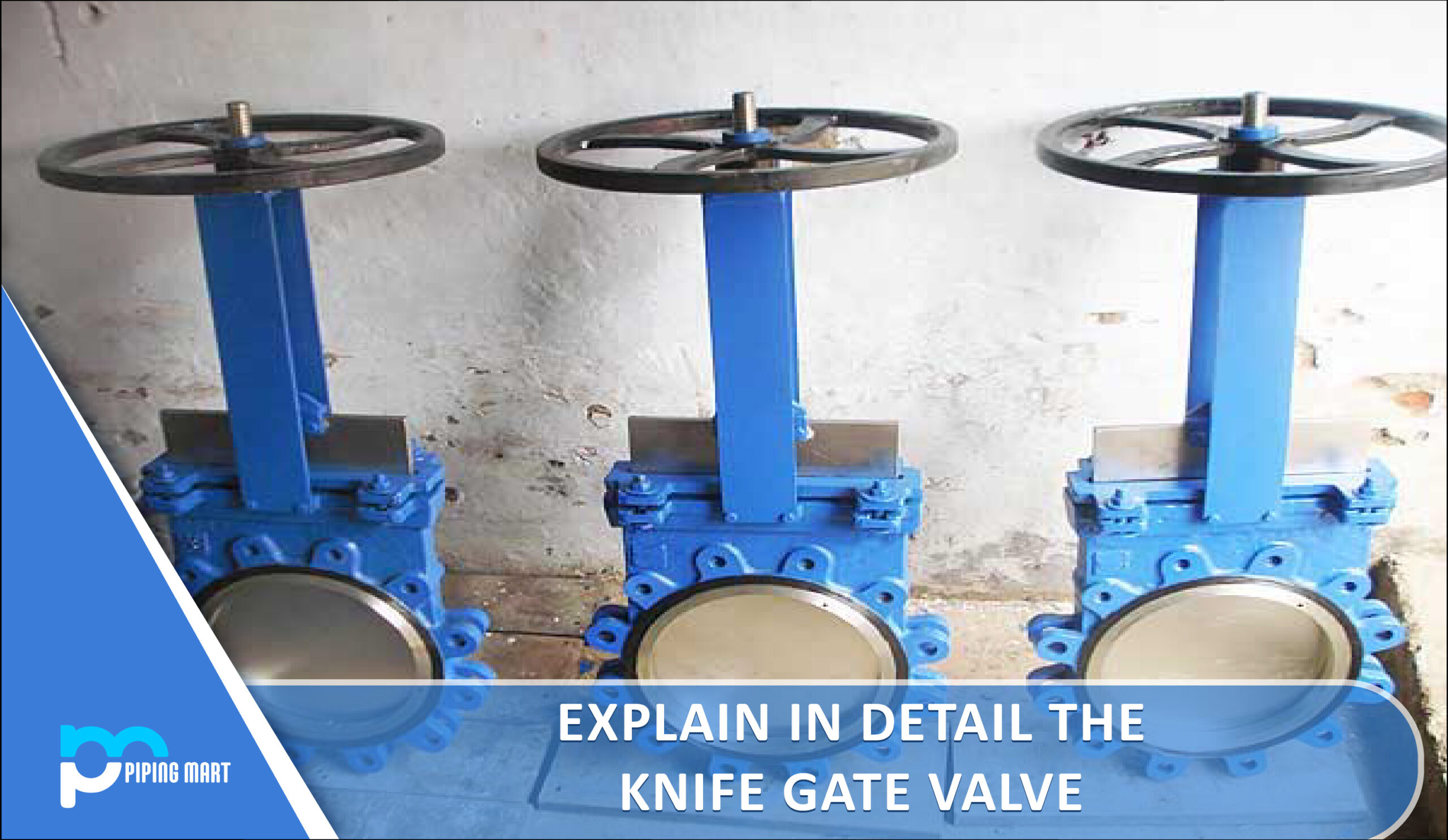The fluid traveling through the pipes is particularly thick in sectors like pulp and paper. The typical valve had some leakage and could not accurately halt the flow. The knife gate valve was developed to address these problems in fields using highly viscous fluids.
This valve was explicitly created to work in a piping system that transports thick, sticky fluid. Since its initial introduction in 1927, the knife gate valve has seen extensive application worldwide.
What is a Knife gate valve?
An example of a shut-off valve is a knife gate valve. The flow in the piping is started and stopped using this. A piping system that transports gas or liquid is mainly used. Specialized pipe system for the flow of high-density material.
A knife gate valve gate is constructed with sharp edges to cut through dense material moving through the pipe. This valve uses the pressure drop feature to halt the flow when necessary. This guarantees that the valve is completely shut and that there are no leaks.
The Gate of a knife gate valve with a knife form removes the hard or sticky substance. Additionally, it ensures that no extra material gets wedged between the valve’s parts. Additionally, this guarantees that material surplus won’t compromise cleanliness.
Parts of the Knife Gate valve
One of the essential parts of any gate valve is the Gate. However, a knife-style gate valve is designed to halt highly viscous and sticky fluid. This has always been constructed of stainless steel to resist corrosion.
Valve Body: The material used to construct KGVs’ bodies is typically industrial-grade carbon steel, though requirements and environmental factors may cause this to change.
When the valve is closed, the Gate sits on the valve seat. Stainless steel makes up most of the valve seat to endure and resist corrosion. For lower-size valves, PVC or plastic is also used. This portion of the valve makes sure that there are no leaks.
Stem: The valve’s actual shaft, which is connected to the Gate and hand wheel, is referred to here. The Gate can be raised or lowered by rotating the hand wheel.
Hand wheel: This facilitates operation. The knife gate valve allows you to start or stop the fluid flow by spinning it. If you want to operate the valve remotely, you may also use an electric motor or hydraulic system in its place.
Classification of Knife gate valve
- By Bode material
- Carbon steel KGVs
- Stainless steel KGVs
- Lines Valves
- By Connection Types
- Wafer type
- Lug type
- Flanged
- By sealing method
- Metal seated
- Resilient seated
- By stem Type
- Rising stem
- Non-Rising stem
How does Knife Gate Valve Work?
A knife gate valve features a part with a blade to cut through pipe clogs made of high-density fluid. The most corrosive and abrasive conditions in industrial operations are designed to work with this kind of valve.
These valves are designed to seat the blade into an elastomer when the valve is closed and have low-pressure restrictions. The chemical being handled in the pipe was cut by the valve’s Knife when it closed. When powder or solid mass goes through the knife gate valve, it collects on the seat and prevents it from tightly shutting. The in this instance, it needs to be changed.
Type of Knife gate valve
There are three varieties of knife gate valves on the market:
- Knife gate valve in the hopper shape
- Knife gate valve in the wafer style
- Thru gate valve and conduit
Hopper Shape Knife gate valve
- KGVs of this kind are intended to be unidirectional. These were created for applications involving bulk handling services. The unique body form makes it easy for the fluid to travel through and makes it perfect for use as a silo exit valve. This valve is frequently utilized in sectors including:
- Power plant
- Food and beverage
- Chemical Plants
- Mining
To prevent issues like build-up in the valve body, seat wear, and challenging closing, these valves are typically fitted in the opposite position or “Seat in the upstream direction.”
Wafer Knife Gate Valve
This particular style of knife gate valve has a gate specifically made to function in both directions. This sort of KGV gate installation is sandwiched between its flanged connections. This design guarantees that the valve won’t choke up during shut-off. Some characteristics of these valves include:
Wafer-shaped bidirectional knife gate valve
- Internal guides allow the two-piece cast body, which is connected by screws, to move the Gate smoothly.
- Provides low-pressure dips and high flow rates.
- Industries where wafer-type knife gate valve is frequently used, are:
- Sewage treatment facility.
- Bulk handling of viscous fluids
- Mining and chemical plants, power plants
- Through conduit knife gate valve
In this design, a top and bottom packing gland are used in place of the valve’s seat and two body seats. When the valve is entirely closed, these seats enclose it. This valve emits fugitive emissions and has high thru leakage.
Fluids with a lot of fiber often function well with this valve. The large scale has also been successful in mineral processing facilities since it aids the valve’s ability to seal completely.
Features of knife gate valve
- Longer valve life and improved reliability are guaranteed by the unibody design and robust, heavy-duty construction.
- Heavy slurries can be cycled through the valve without sticking because of its flexible two-piece sleeve design.
- It is simple to replace sleeves without disassembling the valve.
- In addition to packing less, which eliminates the need for routine adjustment, the replaceable top seal design (sizes 2″ through 16″) also features a self-lubricating system. It is rechargeable without requiring a valve disassembly.
- Pressure drop and turbulence are decreased by complete port design.
- Large solids and highly concentrated materials can be purged using an open bottom.
- Dual-direction cutoff
- Wafer design conserves pipeline area.
- A range of materials is available for sleeves to handle applications, including abrasion and chemicals.
- The lower discharge vent can be cleaned periodically and flushed as necessary using the flushing plate option.
- Less working force is required after extended dormant periods thanks to the enclosed bronze stem bushing with a shielded grease chamber.
- External contamination is prevented with upper stem protection and an optional lower stem cover.
Use of Knife gate valve
Knife gate valves are in great demand in sectors that work with viscous material due to their expertise in handling thick liquids. These valves are utilized exclusively in applications that include difficult-to-clean materials. The following list of industries uses knife gate valves:
- Mining and processing of minerals
- Wastewater Treatment
- Manufacturing of steel and paper
- Transportation of slurry
- Food and drink
- Conveyance for heavy oil
- Units for non-flammable viscous fluid processing
- Plants for sand and gravel
Benefits of Knife gate valve
- Knife gate valves offer a shallow and smooth transition for flow when fully opened.
- Here, the flow may go either way.
- Any position may be used to place the valve. However, it is desirable for the flywheel to be on top and for the stem to be perpendicular to the ground.
- Even for pipes with large nominal diameters and a shorter valve length.
- readily and affordably accessible everywhere.
- For high pressures, certain types are appropriate.
- Simple to maintain
Difference between Knife gate valve and gate valve
The application type or medium these valves handle has a significant effect. Gate valves are less effective at handling slurries, powder, or thick fluids than knife gate valves. On the other hand, a gate valve needs clean fluid to operate correctly.
The fact that the Knife gate valves are developed following TAPPI standards, as opposed to ANSI requirements for Gate valves, is another distinction between the two types of valves.
Gate valves contain a single metal seating, are bi-directional, and are frequently employed in fluid applications. While the sitting materials for KGVs might be constructed of metal, plastic, or PVC.
Another characteristic is the packing gland of the valve. When a gate valve is used, a V-ring packing closes the shaft that connects to the Gate, whereas a KGV’s gland seals the Gate’s perimeter.
Conclusion
The Normal-type of valve won’t be beneficial in industries processing highly dense and viscous fluids since it will clog the valve and prevent a complete seal from occurring. Knife gate valves were developed in Sweden in 1927 to address this problem.

Pipingmart is B2B portal specializes in industrial, metal and piping products. Also, share latest information and news related to products, materials and different types grades to help business dealing in this industry.




